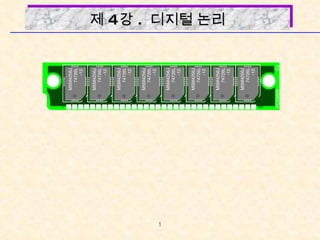
제4강 명제와 논리-정보
- 1. 제 4 강 . 디지털 논리
- 3. 0. 개요 HIGH LOW LOW HIGH +5 +3.5 +0.8 0 전압 [V] +2.5 +1.5 출력신호 입력신호
- 50. 11. 조합회로 조합 논리 회로는 기억 특성을 가지고 있지 않으므로 회로의 출력은 현재 가해지는 입력의 조합에 의해서만 결정된다 . 반가산기 (half adder) 2 진수 한 자리를 더하는 회로를 반가산기라 하며 , 연산회로의 기본이 된다 . 2 개의 비트 X, Y 를 산술적으로 더하여 합 S 와 캐리 C 를 구하는 회로 X Y S C 0 0 0 1 1 0 1 1 0 0 1 0 1 0 0 1
- 51. 11. 조합회로 전가산기 (full adder) X, Y 와 밑자리에서 올라오는 Carry 까지 고려해서 3bit 를 더하여 S , C 를 구하는 회로 (2 개의 반가산기와 1 개의 OR 게이트 ) X Y C i S C 0 0 0 0 0 1 0 1 0 0 1 1 0 0 0 0 0 1 0 1 0 0 1 1 0 0 1 0 1 0 0 1 1 0 0 1 0 1 1 1
- 52. 11. 조합회로 비교기 (comparator) 2 개의 수 A, B 를 비교하여 대소를 결정하는 회로 A B A>B A=B A<B 0 0 0 1 1 0 1 1 0 1 0 0 0 1 1 0 0 0 1 0
- 59. 12. 순서논리회로 S-R 플립플롭 D 플립플롭 S R Q 0 0 0 1 1 0 1 1 불변 1 0 불능 ( 허용 안됨 ) D Q 1 0 1 0
- 60. 12. 순서논리회로 J-K 플립플롭 T 플립플롭 RS 플립플롭에서 R=S=1 을 허용하지 않는 보완한 것이 JK 플립플롭이다 . J,K 값이 동시에 1 이 될때 원래값에 반전된다… Toggle 플립플롭이다 . JK 플립플롭의 입력을 묶어서 하나의 입력 T 로 많든 플립플롭 J K Q 0 0 0 1 1 0 1 1 불변 0 1 토글 ( 반전 ) T Q 0 1 불변 보수
- 61. 13.ROM ROM: Two dimensional array of 1's and 0's Row is called a "word"; index is called an "address" Width of row is called bit-width or wordsize Address is input, selected word is output Dec 0 n-1 Address 2 -1 n 0 Word Line 0011 Word Line 1010 Bit Lines j i +5V +5V +5V +5V
- 62. 13.ROM F0 = A' B' C + A B' C' + A B' C F1 = A' B' C + A' B C' + A B C F2 = A' B' C' + A' B' C + A B' C' F3 = A' B C + A B' C' + A B C' address outputs A B C Address by ROM 8 w ords ¥ 4 bits F 0 F 1 F 2 F 3 B 0 0 1 1 0 0 1 1 W ord Contents A 0 0 0 0 1 1 1 1 C 0 1 0 1 0 1 0 1 F 0 0 1 0 0 1 1 0 0 F 1 0 1 1 0 0 0 0 1 F 2 1 1 0 0 1 0 0 0 F 3 0 0 0 1 1 0 1 0
- 63. 14.ALU
- 64. 14.ALU(32bit)
Notes de l'éditeur
- 안산 1 대학
- 안산 1 대학
- 안산 1 대학
- 안산 1 대학
- 안산 1 대학
- 안산 1 대학
- 안산 1 대학
- 안산 1 대학
- 안산 1 대학
- 안산 1 대학
- 안산 1 대학